
Come Up and See Me Sometime!
9 November 2009Oh where, oh where, has my little blog gone?
13 April 2009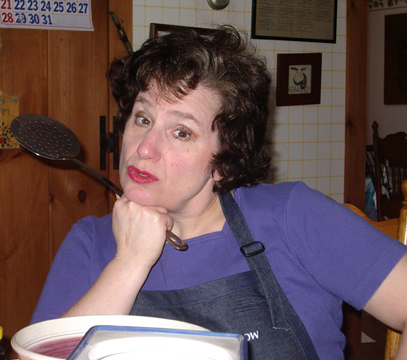
I don’t want to alarm you, dear readers—but soon this blog may disappear from the internet for a couple of days.
I will be switching it over to a slightly different blogging platform this week. Apparently, while it is in transition In Our Grandmothers’ Kitchens could cease to exist for up to 48 hours.
I promise I’ll come back—better than ever! Meanwhile, I’ll be thinking of you (and cooking for you)……….
Tinky
P.S. MUCH LATER: My blog is back up at a new location: http://www.ourgrandmotherskitchens.com! Please come visit……..
Peanut Butter Easter Eggs
11 April 2009 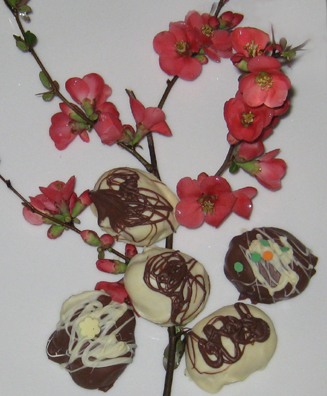
I don’t know what made Mr. Reese decide in 1928 to put peanut butter together with chocolate, but I have always been glad he did. As a pairing it’s right up there with Greer Garson and Walter Pidgeon, dogs and kids, and friends and cooking. The cups make great Easter eggs as well.
Here is a homemade (and truly delicious) version of this classic treat.
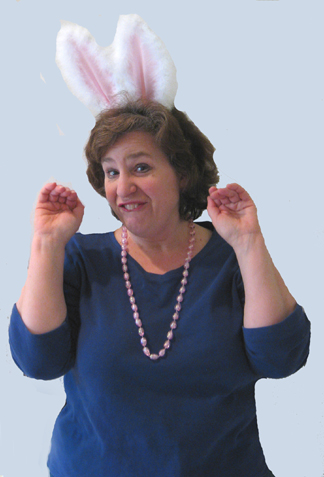
- Happy Easter!
Ingredients:
1/3 cup graham cracker crumbs
1/2 cup confectioner’s sugar
1/4 cup brown sugar
about 1 pound chocolate—milk, semi-sweet, white, or a combination (you may swirl them together as we did in the photo)
Instructions:
When you are ready to complete the process, put the chocolate in a double boiler over hot water. Melt it, stirring frequently. Remove it from the heat.
Dip the eggs in the chocolate, and place them on wax paper or a silicone mat to harden (this will take several hours—be patient!).
Makes about 16 irresistible eggs. Keep them from getting too warm, and try to eat them within 48 hours. My family had no trouble doing this!

Nana’s Matzo Ball Soup
9 April 2009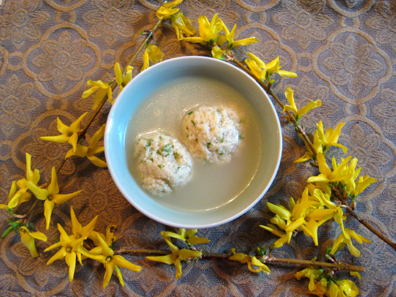
Laura at the blog The Spiced Life understands this connection. She is hosting a blogging event in which she asks food bloggers to write about their grandmothers’ culinary accomplishments. I went to my paternal grandmother’s house every spring for Passover so I tend to think of her a lot at this time of year.
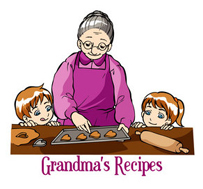
The Logo for Laura's Blogging Event
My father’s mother wasn’t what I’d call kitchen oriented. As a young woman she lived a busy life outside the home instead of cooking. We were told she had been a spy in her youth (or at least a smuggler—the tales were all a little murky).
Sarah Hiller Weisblat came to this country from Poland in 1920 with her husband and three small children. Her brothers had already immigrated and set up a business in New York City; they gave my grandfather a job so that he could support the family.
My grandmother had many skills. She and her mother, who also immigrated (although she refused to learn English), ran their family and eventually their new neighborhood.
My grandmother radiated competence. I recently learned from my father’s cousin Herb that she delivered him. I don’t know whether a midwife or doctor was unavailable or whether this was something my Nana did on a semi-regular basis!
She was also diplomatic (perhaps a hangover from her days as a spy). When my Jewish father fell in love with my Christian mother, neither set of parents was thrilled. It wasn’t a time when a lot of intermarriage took place. Nevertheless, my grandmother welcomed my mother to the family and defended her against any criticism. She recognized a fellow smart, able woman when she saw one.
As I noted above, my grandmother didn’t do a lot in the kitchen, at least not by the time I met her. Perhaps her mother was the family cook. My father used to recall seeing a carp swimming in the bathtub in his childhood just before it was time to make gefilte fish. In my youth the gefilte fish came out of a jar.
(Although I’m a fan of fresh foods, I think in retrospect this was probably just as well; I would have yelled bloody murder at bath time if I’d seen a fish in the porcelain before me, no matter how thoroughly the tub had been scrubbed!)
I do remember two things that my grandmother made well and on a regular basis—pot roast and matzo ball soup. The matzo ball soup was particularly visible at Passover since the most prominent food on the Passover table is matzo, unleavened bread. When the Jews were finally allowed to leave Egypt in the Exodus story, they were in such a hurry that they baked their bread without letting it rise. In commemoration of this event their descendants eat no bread except matzo during Passover, which lasts for eight days. Matzo meal (ground matzo) is a staple of Passover cooking.
The trick to this soup is not to make the matzo balls too big; if you do, they swell up and overwhelm your soup! You may of course jazz up the soup by adding chopped vegetables and/or a little ginger to the matzo balls. As a sodium freak I actually like to add a drop of soy sauce to my stock. My grandmother made basic matzo ball soup, however, so basic matzo ball soup this is.
When I make or taste it I am transported back to the home at which we visited my grandparents in Long Beach, New York. This tiny house always seemed to expand to accommodate the many relatives and friends who came to visit, particularly at Passover. My grandmother’s Seder table there was a symbol of her hospitality, of her generous personality, and of the ties that brought family and friends together at holidays. It was never without matzo ball soup.
For more information about Laura’s Grandma’s Recipes event, click here. Meanwhile, here is MY grandma’s recipe.

The Weisblat Family a few months before coming from Poland to the United States. From left to right: Sarah, Selma, Benny, Baby Abe (my father!), and William (then known as Wolf)
Ingredients:
2 eggs
2 tablespoons minced fresh parsley
2 tablespoons minced fresh dill
a small amount of finely chopped onion (optional)
2 tablespoons soda water
2 tablespoons extra-virgin olive oil or melted butter
3/4 teaspoon salt
freshly ground pepper
1/2 cup matzo meal
6 cups chicken stock
Instructions:
In a small bowl, beat the eggs. With a balloon whisk, whisk in the parsley, dill, onion (if using), soda water, oil, salt, and pepper. Then stir in the matzo meal. Cover the mixture, and refrigerate it for at least an hour but not more than 6 hours.
Oil your hands, and shape the dough into small balls (about 1/2 inch across). Pop the balls CAREFULLY into salted boiling water.
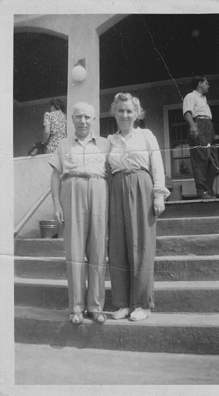
My Grandparents Later in Life (perhaps the 1940s?)
Community Easter Bread
7 April 2009
Leigh watches Michael and Benjamin place their eggs in the bread.
This symbol of spring represents fertility, youth, and new beginnings—all the hopes that suddenly arise in our breasts when the sun rises higher and earlier again in the spring.
This braided loaf is made more festive (and more seasonal) by the inclusion of eggs in its folds. Plain eggs work just fine, but I always welcome an excuse to get kids coloring things so I asked my nephew Michael and his friends Benjamin and Carson to dye some eggs for my loaf.

Carson rolls an egg in his dye.
I got extra help from my sister-in-law Leigh, who is MUCH better at braiding bread than I am.
So my Easter bread is a community event. I hope yours will be, too!

Leigh braids the rolls of bread.
Ingredients:
2/3 cup milk
2 tablespoons sweet butter
1/4 cup sugar
1 packet yeast
2-1/2 cups flour (approximately)
1 teaspoon salt
2 eggs for the batter
4 to 5 eggs in their shells for the braiding (dyed if you like)
Instructions:
In a small saucepan heat the milk and butter just to lukewarm; the butter will be soft but not melted.
In a medium bowl combine 1 teaspoon of the sugar and the yeast. Pour the milk/butter mixture over them, and leave the yeast to proof for 5 to 10 minutes.
Beat in 1/2 cup flour, the remaining sugar, the salt, and the 2 eggs; mix well. Add 1-1/2 cups more flour, and stir.
Turn the dough out onto a floured board. Knead it for 1 to 2 minutes, adding a bit more flour as needed. Allow the dough to rest for 5 to 10 minutes; then continue kneading, adding more flour as needed, until the dough is smooth and elastic.
Grease a medium bowl, and place the dough in it. Cover with a damp towel, and allow the dough to rise until it doubles in bulk, about 1 hour.
Uncover the dough, punch it down, and divide it into 2 mounds. Let them rest for 5 to 10 minutes. Stretch each mound into a roll at least 24 inches long.
Form a rounded braid with the two rolls, sealing them at the ends. Place the bread on a greased (or parchment-covered) baking sheet. Insert the eggs in their shells into spots in the braid. (If you wait to do this until the bread has risen again, the eggs will pop out of the bread; this happened to us!)
Cover the braid with a damp dish towel, and let it rise until it doubles, about 45 minutes to 1 hour. Preheat the oven to 350 degrees about 15 minutes before you want to bake the bread.
Bake the braided bread until it is a golden brown, between 35 and 55 minutes depending on your oven. Makes 1 loaf.
